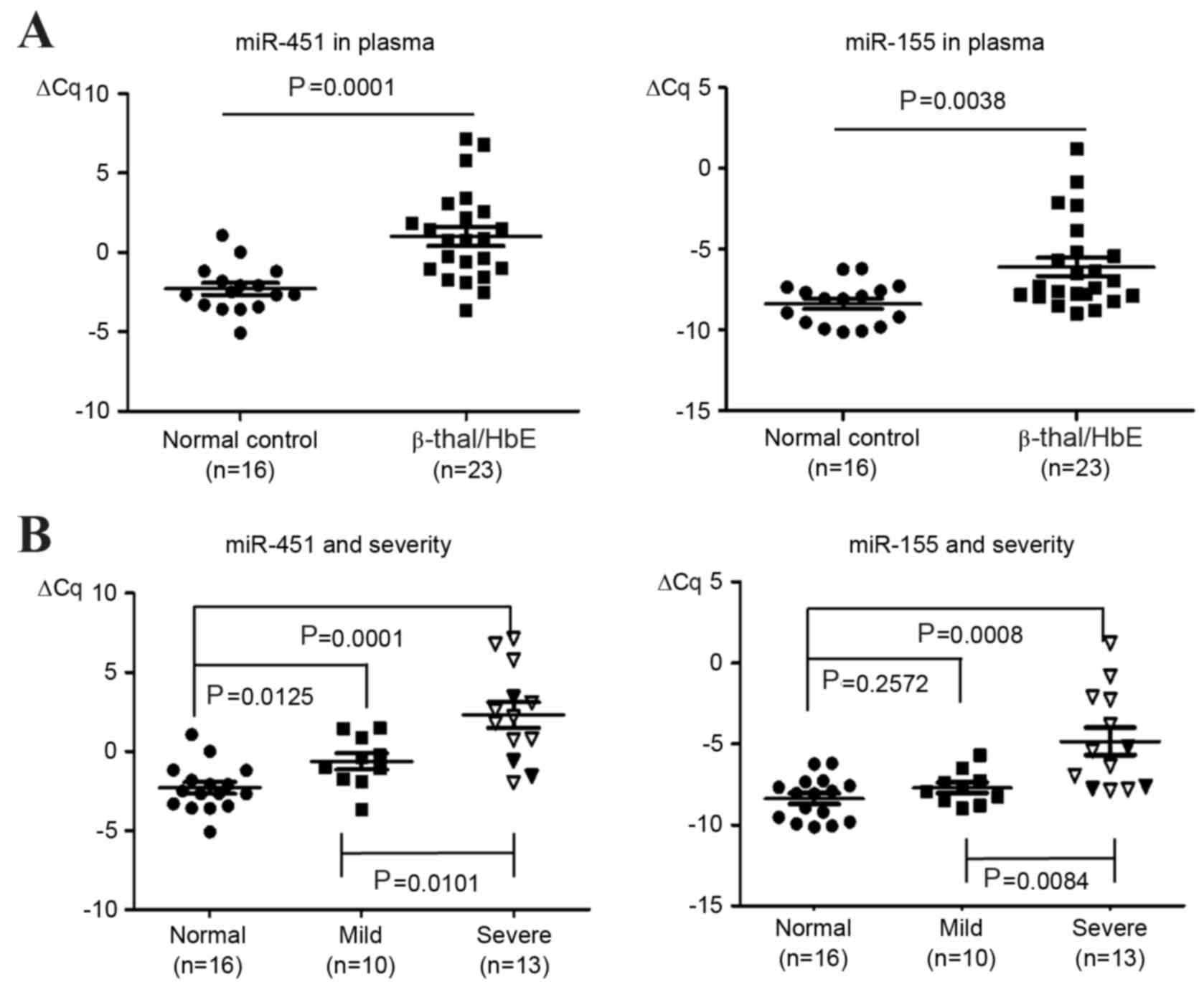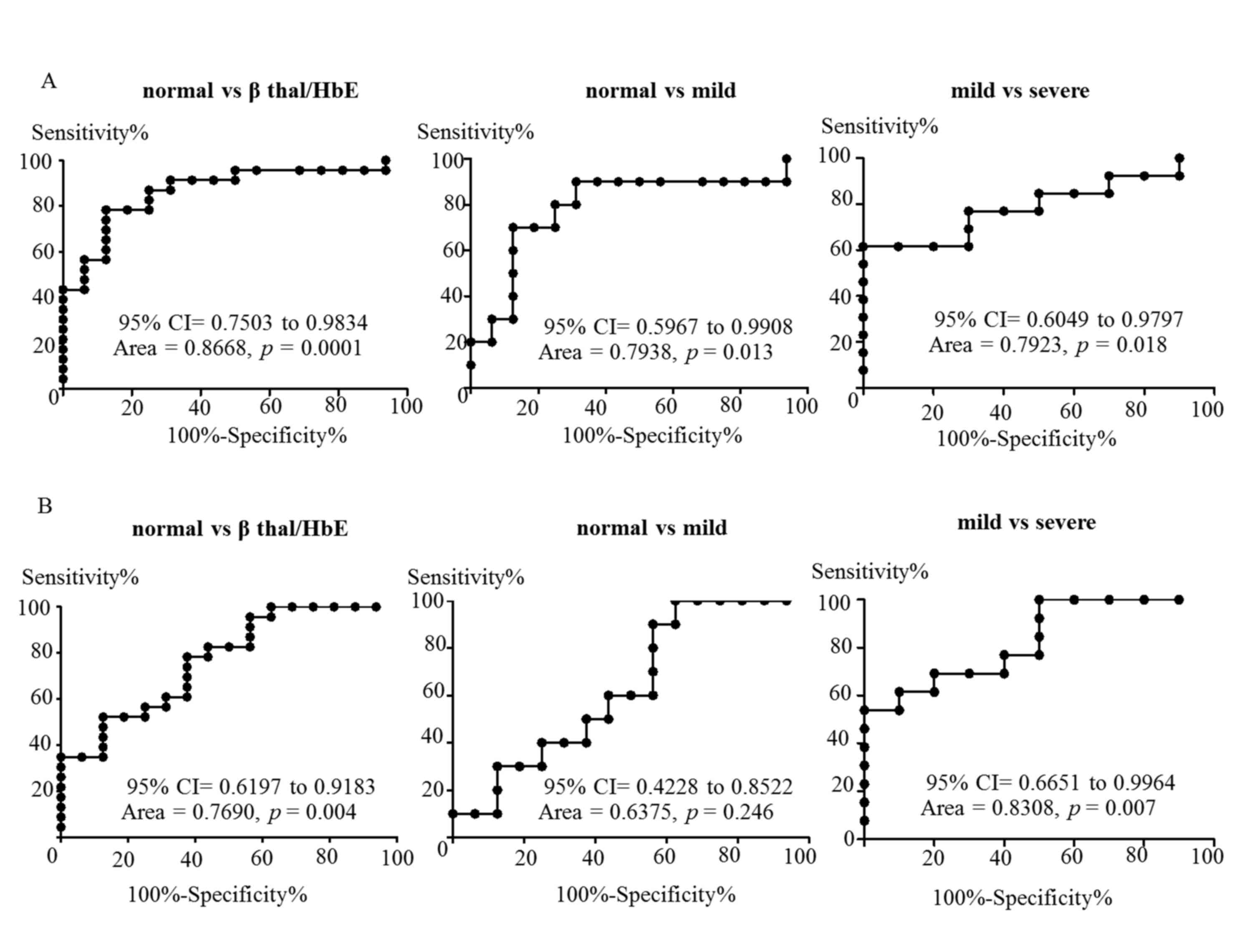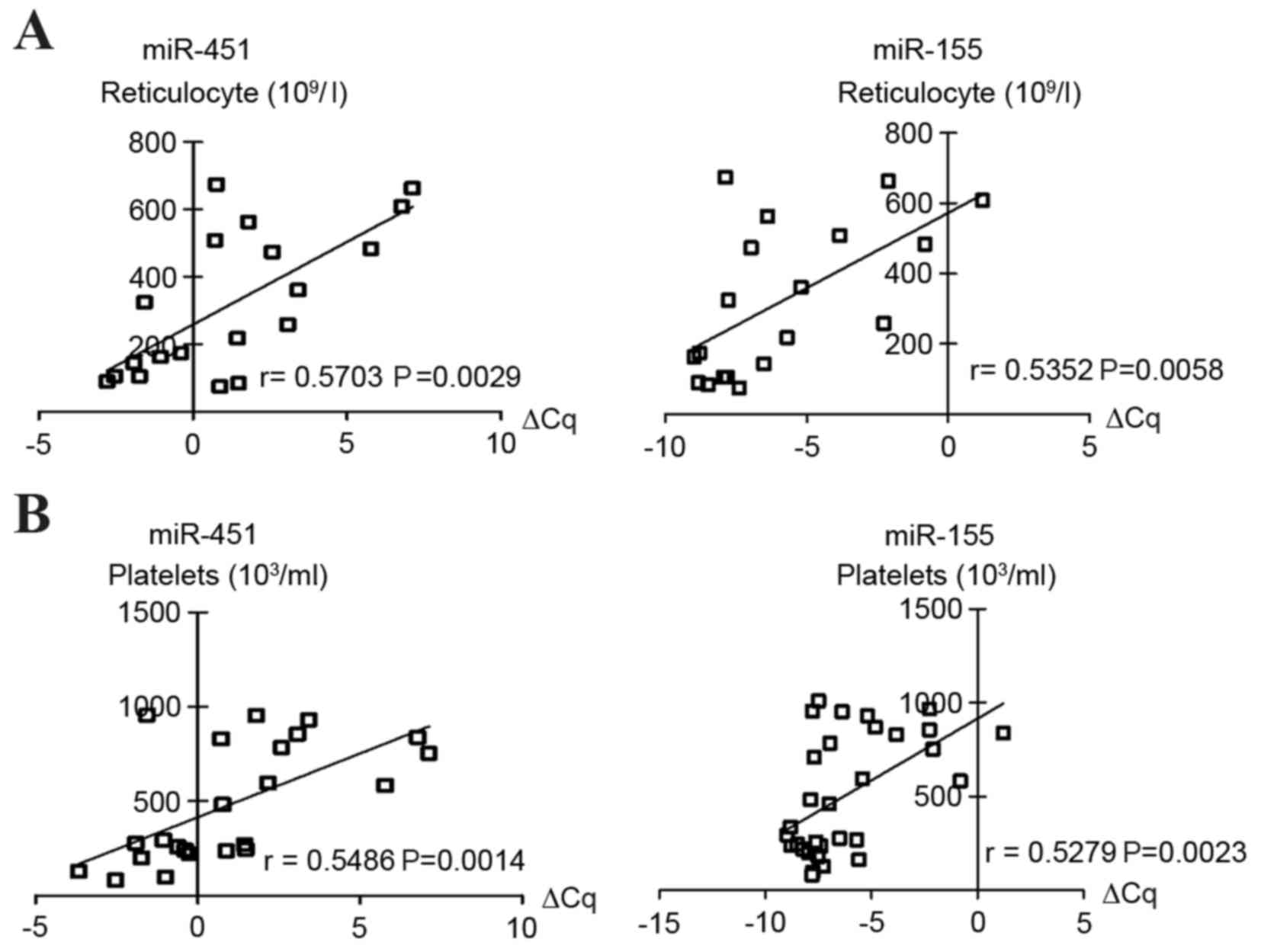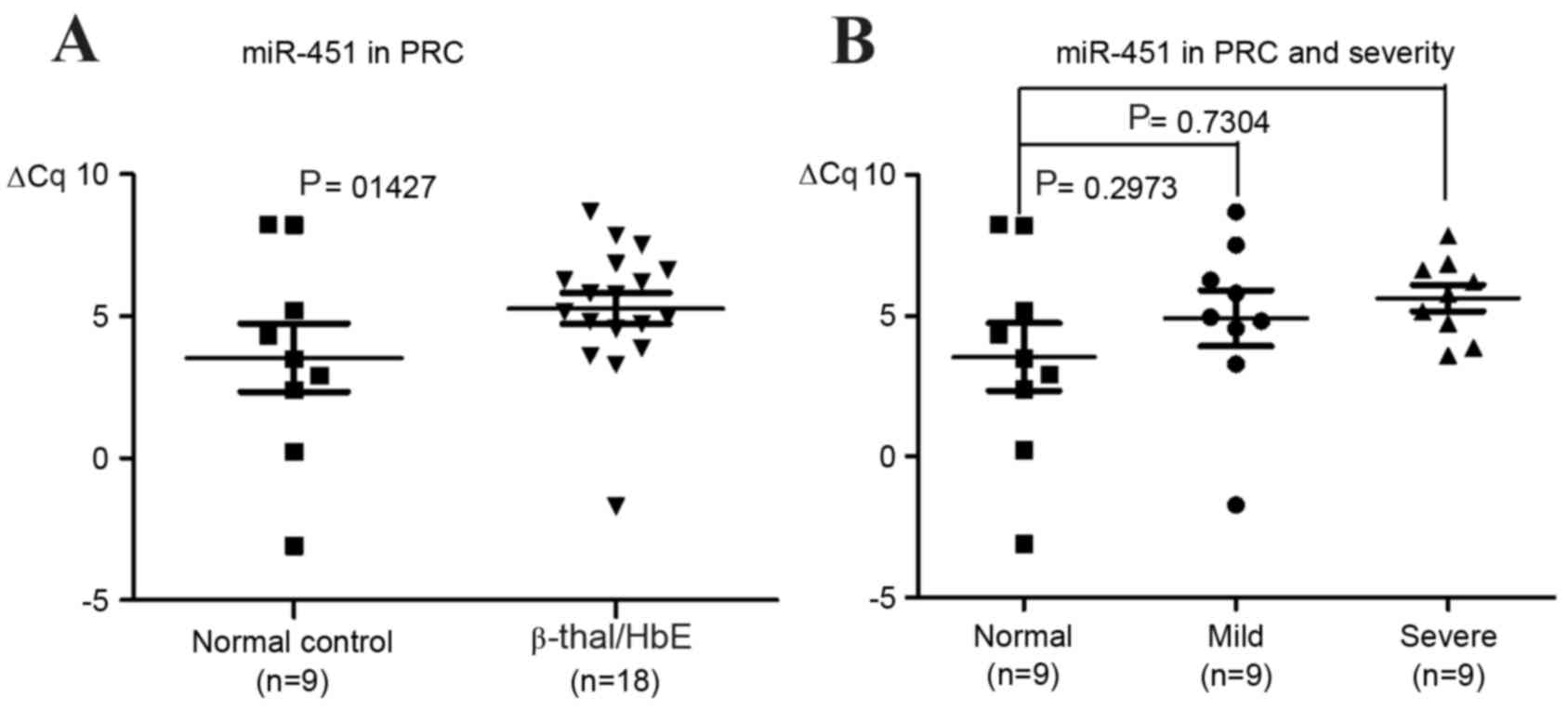|
1
|
Olivieri NF: The beta-thalassemias. N Engl
J Med. 341:99–109. 1999. View Article : Google Scholar : PubMed/NCBI
|
|
2
|
Fucharoen S and Winichagoon P: Clinical
and hematologic aspects of hemoglobin E beta-thalassemia. Curr Opin
Hematol. 7:106–112. 2000. View Article : Google Scholar : PubMed/NCBI
|
|
3
|
Vichinsky E: Hemoglobin e syndromes.
Hematology Am Soc Hematol Educ Program. 79–83. 2007.PubMed/NCBI
|
|
4
|
Fucharoen S and Winichagoon P:
Hemoglobinopathies in southeast Asia. Hemoglobin. 11:65–88. 1987.
View Article : Google Scholar : PubMed/NCBI
|
|
5
|
Rund D and Rachmilewitz E:
Beta-thalassemia. N Engl J Med. 353:1135–1146. 2005. View Article : Google Scholar : PubMed/NCBI
|
|
6
|
Olivieri NF, Pakbaz Z and Vichinsky E: Hb
E/beta-thalassaemia: A common & clinically diverse disorder.
Indian J Med Res. 134:522–531. 2011.PubMed/NCBI
|
|
7
|
Thein SL: Pathophysiology of beta
thalassemia-a guide to molecular therapies. Hematology Am Soc
Hematol Educ Program. 31–37. 2005.PubMed/NCBI
|
|
8
|
Weatherall DJCJ: The thalassemia
syndromes. Malden MA Blackwell Science. 2001.
|
|
9
|
Conran N: Intravascular hemolysis: A
disease mechanism not to be ignored. Acta Haematol. 132:97–99.
2014. View Article : Google Scholar : PubMed/NCBI
|
|
10
|
Atichartakarn V, Chuncharunee S,
Archararit N, Udomsubpayakul U and Aryurachai K: Intravascular
hemolysis, vascular endothelial cell activation and thrombophilia
in splenectomized patients with hemoglobin E/β-thalassemia disease.
Acta Haematol. 132:100–107. 2014. View Article : Google Scholar : PubMed/NCBI
|
|
11
|
Bartel DP: MicroRNAs: Genomics,
biogenesis, mechanism, and function. Cell. 116:281–297. 2004.
View Article : Google Scholar : PubMed/NCBI
|
|
12
|
Filipowicz W, Bhattacharyya SN and
Sonenberg N: Mechanisms of post-transcriptional regulation by
microRNAs: Are the answers in sight? Nat Rev Genet. 9:102–114.
2008. View
Article : Google Scholar : PubMed/NCBI
|
|
13
|
Miska EA: How microRNAs control cell
division, differentiation and death. Curr Opin Genet Dev.
15:563–568. 2005. View Article : Google Scholar : PubMed/NCBI
|
|
14
|
Roth C, Rack B, Müller V, Janni W, Pantel
K and Schwarzenbach H: Circulating microRNAs as blood-based markers
for patients with primary and metastatic breast cancer. Breast
Cancer Res. 12:R902010. View
Article : Google Scholar : PubMed/NCBI
|
|
15
|
Lawrie CH, Gal S, Dunlop HM, Pushkaran B,
Liggins AP, Pulford K, Banham AH, Pezzella F, Boultwood J,
Wainscoat JS, et al: Detection of elevated levels of
tumour-associated microRNAs in serum of patients with diffuse large
B-cell lymphoma. Br J Haematol. 141:672–675. 2008. View Article : Google Scholar : PubMed/NCBI
|
|
16
|
Chen Y, Gelfond JA, McManus LM and
Shireman PK: Reproducibility of quantitative RT-PCR array in miRNA
expression profiling and comparison with microarray analysis. BMC
Genomics. 10:4072009. View Article : Google Scholar : PubMed/NCBI
|
|
17
|
Reid G, Kirschner MB and van Zandwijk N:
Circulating microRNAs: Association with disease and potential use
as biomarkers. Crit Rev Oncol Hematol. 80:193–208. 2011. View Article : Google Scholar : PubMed/NCBI
|
|
18
|
Mitchell PS, Parkin RK, Kroh EM, Fritz BR,
Wyman SK, Pogosova-Agadjanyan EL, Peterson A, Noteboom J, O'Briant
KC, Allen A, et al: Circulating microRNAs as stable blood-based
markers for cancer detection. Proc Natl Acad Sci USA.
105:10513–10518. 2008. View Article : Google Scholar : PubMed/NCBI
|
|
19
|
Masaki S, Ohtsuka R, Abe Y, Muta K and
Umemura T: Expression patterns of microRNAs 155 and 451 during
normal human erythropoiesis. Biochem Biophys Res Commun.
364:509–514. 2007. View Article : Google Scholar : PubMed/NCBI
|
|
20
|
Pase L, Layton JE, Kloosterman WP,
Carradice D, Waterhouse PM and Lieschke GJ: miR-451 regulates
zebrafish erythroid maturation in vivo via its target gata2. Blood.
113:1794–1804. 2009. View Article : Google Scholar : PubMed/NCBI
|
|
21
|
Kim M, Tan YS, Cheng WC, Kingsbury TJ,
Heimfeld S and Civin CI: MIR144 and MIR451 regulate human
erythropoiesis via RAB14. Br J Haematol. 168:583–597. 2015.
View Article : Google Scholar : PubMed/NCBI
|
|
22
|
Bruchova-Votavova H, Yoon D and Prchal JT:
miR-451 enhances erythroid differentiation in K562 cells. Leuk
Lymphoma. 51:686–693. 2010. View Article : Google Scholar : PubMed/NCBI
|
|
23
|
Zhan M, Miller CP, Papayannopoulou T,
Stamatoyannopoulos G and Song CZ: MicroRNA expression dynamics
during murine and human erythroid differentiation. Exp Hematol.
35:1015–1025. 2007. View Article : Google Scholar : PubMed/NCBI
|
|
24
|
Svasti S, Masaki S, Penglong T, Abe Y,
Winichagoon P, Fucharoen S and Umemura T: Expression of
microRNA-451 in normal and thalassemic erythropoiesis. Ann Hematol.
89:953–958. 2010. View Article : Google Scholar : PubMed/NCBI
|
|
25
|
Faraoni I, Antonetti FR, Cardone J and
Bonmassar E: miR-155 gene: A typical multifunctional microRNA.
Biochim Biophys Acta. 1792:497–505. 2009. View Article : Google Scholar : PubMed/NCBI
|
|
26
|
Zhu W, Qin W, Atasoy U and Sauter ER:
Circulating microRNAs in breast cancer and healthy subjects. BMC
Res Notes. 2:892009. View Article : Google Scholar : PubMed/NCBI
|
|
27
|
Eis PS, Tam W, Sun L, Chadburn A, Li Z,
Gomez MF, Lund E and Dahlberg JE: Accumulation of miR-155 and BIC
RNA in human B cell lymphomas. Proc Natl Acad Sci USA.
102:3627–3632. 2005. View Article : Google Scholar : PubMed/NCBI
|
|
28
|
Winichagoon P, Saechan V, Sripanich R,
Nopparatana C, Kanokpongsakdi S, Maggio A and Fucharoen S: Prenatal
diagnosis of beta-thalassaemia by reverse dot-blot hybridization.
Prenat Diagn. 19:428–435. 1999. View Article : Google Scholar : PubMed/NCBI
|
|
29
|
Sripichai O, Makarasara W, Munkongdee T,
Kumkhaek C, Nuchprayoon I, Chuansumrit A, Chuncharunee S,
Chantrakoon N, Boonmongkol P, Winichagoon P and Fucharoen S: A
scoring system for the classification of beta-thalassemia/HbE
disease severity. Am J Hematol. 83:482–484. 2008. View Article : Google Scholar : PubMed/NCBI
|
|
30
|
Arce-Bejarano R, Lomonte B and Gutiérrez
JM: Intravascular hemolysis induced by the venom of the Eastern
coral snake, Micrurus fulvius, in a mouse model: Identification of
directly hemolytic phospholipases A2. Toxicon. 90:26–35. 2014.
View Article : Google Scholar : PubMed/NCBI
|
|
31
|
Ragab SM, Safan MA and Badr EA: Study of
serum haptoglobin level and its relation to erythropoietic activity
in Beta thalassemia children. Mediterr J Hematol Infect Dis.
7:e20150192015. View Article : Google Scholar : PubMed/NCBI
|
|
32
|
Okumiya T, Ishikawa-Nishi M, Doi T,
Kamioka M, Takeuchi H, Doi Y and Sugiura T: Evaluation of
intravascular hemolysis with erythrocyte creatine in patients with
cardiac valve prostheses. Chest. 125:2115–2120. 2004. View Article : Google Scholar : PubMed/NCBI
|
|
33
|
Rother RP, Bell L, Hillmen P and Gladwin
MT: The clinical sequelae of intravascular hemolysis and
extracellular plasma hemoglobin: A novel mechanism of human
disease. JAMA. 293:1653–1662. 2005. View Article : Google Scholar : PubMed/NCBI
|
|
34
|
Mock DM, Matthews NI, Zhu S, Strauss RG,
Schmidt RL, Nalbant D, Cress GA and Widness JA: Red blood cell
(RBC) survival determined in humans using RBCs labeled at multiple
biotin densities. Transfusion. 51:1047–1057. 2011. View Article : Google Scholar : PubMed/NCBI
|
|
35
|
Painter PC, Van Meter S, Dabbs RL and
Clement GE: Analytical evaluation and comparison of Dupont aca
lactate dehydrogenase-1 (LD1) isoenzyme assay diagnostic efficiency
for acute myocardial infarction detection with other LD1 methods
and aca CK-MB. A two-site study. Angiology. 45:585–595. 1994.
View Article : Google Scholar : PubMed/NCBI
|
|
36
|
Rasmussen KD, Simmini S, Abreu-Goodger C,
Bartonicek N, Di Giacomo M, Bilbao-Cortes D, Horos R, Von Lindern
M, Enright AJ and O'Carroll D: The miR-144/451 locus is required
for erythroid homeostasis. J Exp Med. 207:1351–1358. 2010.
View Article : Google Scholar : PubMed/NCBI
|













